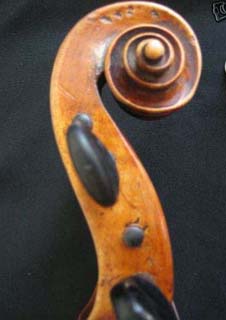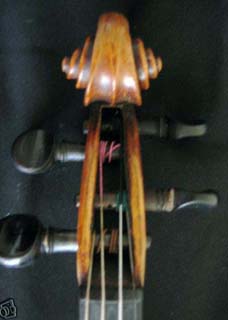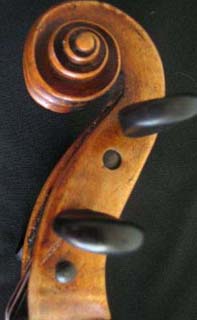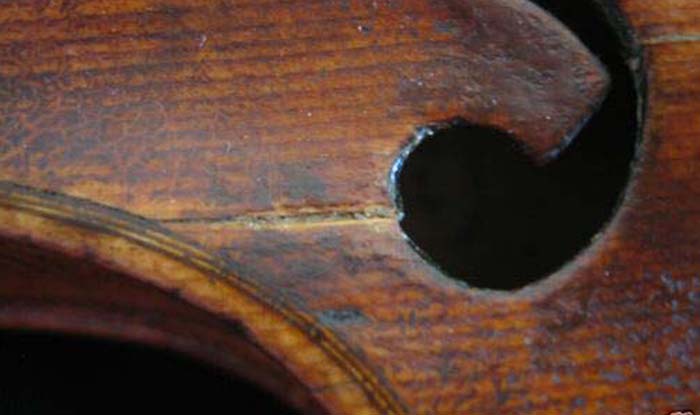a beautiful mystery labelled Nicolaus Amatus 1682 |
This was my second Ebay auction acquisition. I had never seen a fiddle that looked so old (the ample photos were top notch). I wasn't sure if it was a treasure or a trasher. I just had an unquenchable need to hear the timbre of an early piece of work, and this certainly looked the part. It is heavily scarred and looks decrepit, but holds pitch very well. The golden orange varnish and general build have me entertaining the possibility of an experimental 'long form' by an early Italian maker. On the other hand, it may just be an early Schweitzer copy. |
The belly's upper treble area is scarred severely and the edge is nicked. Chipping of the original varnish is ubiquitous and reveals a very neutral (propolis?) ground of a blond color. I believe it has received a restrained 'overcoat' of clear varnish at some point. The coloration of the varnish is a light chestnut brown with an orange tint. The one piece back is slab cut and the corners are abrupt and somewhat shortened. The distance between the tops of the 'f' holes is very close. The lower wings are heavily fluted and rise gracefully into the deep channel of the mid bout. |
 |
 |
 |
It's most salient feature is the scroll, which has one full extra turn. Although pitted with toolmarks, they gather depth as they wind at a uniform rate. Notice the composition of the wood used for the head. It is a fine piece of quartersawn with hardly any pronounced grain -- smartly chosen for ease of carving. |
The rib height is rather low, just approaching 1". I am not able to identify the wood. |
A look across the 'f' hole shows the thinness of the top plate at the midbouts. The oil varnish was pushed into the crevices where it 'puddled', leaving a darker hue. I see no evidence of attempts at stripping or refinishing. |
(top L) the chip out of the edge is coincidently along the fault of the 'fake' or 'repaired' crack, depending on your viewpoint. Scratch marks show an intended but aborted neck graft and scars on the heel butt might be from a heel graft instead. The heel button is quite tapered and well met but with no signs of an additional wedge. |
 |
As to the make or maker, I have not the experience to gainsay even a shred of a guess. The label has a hand inked 82 after the printed 16. |
 |
Although I had marvelled at the delicacy of this purfling for years, I never noticed until mounting this photo for the web that it is composed of not three, but a five band composite that lies very close to the edge of the plate. Whoever made this piece was certainly trying to prove something. The work is very delicate and precise and for some strange reason, I always got the impression of a woman's patient hand at work. |
Ebony locating pins are centrally located 1/4" in from the purfling at top and bottom. The heel button has a 1/4" wooden dowel. Above, right, a 1/4" wide ebony strip divides the ribbing at the tail block. |
A lot of people think this is a fake crack. I do not. The top plate is so thin that it could have been accidentally split and rejoined before the final assembly. The other one is in the upper treble side of the table where the section of the edge is missing. |
I believe the crack lines in the table are good joins done before the final assembly. I don't know what the interior looks like, maybe they're cleated or clothed with linen. Below, a good look at the back shows the chipping of the original varnish. |
MEASURMENTS |
SOUND -- Rarely are these auction pieces ever set up correctly as received by the buyer -- probably why there on the block! After nine years of experiments and adjustments (new bridge & soundpost in their optimun locations), and the right string choice, the voice is now resembling that of the finer instruments heard on recordings. A very sweet accord on the double stops, with a soprano like timbre and good expression. The sound is rich, but not powerful or boomy. Chords are sweetly harmonious. The G string is sweet and true but lacks some clarity, probably due to a loosened bass bar. What it lacks in power, it makes up for in attenuation and sympathy. Overall, a distinct voice that imparts a touching and intimate experience to both the player and the listener. |
return to the gallery page by clicking the link below http://stnichsigns.com/Makers'Orphans.html |